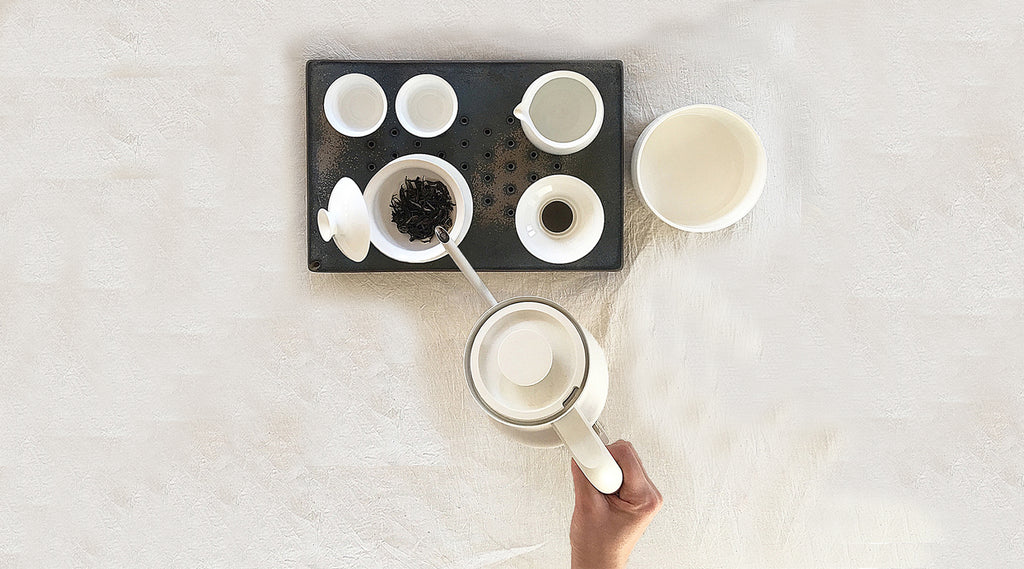6 Reasons to Brew with a Gaiwan (vs. Infuser, Yixing Claypot)
Reading time: 4 minutes
Mansa Tea is a handcrafted aged tea company that specializes in aged teas, tea experiences, and education for modern connoisseurs. We aim to elevate tea experiences at Michelin-starred restaurants and luxury hotels so that tea enthusiasts can taste aged tea at its peak as part of their fine dining experience.
This article is just one part of the Mansa Tea Education blog series. Subscribe to our newsletter to become a tea connoisseur.
Do You Brew Your Tea With a Gaiwan?
Tea lovers know that loose leaf tea offers a superior taste to tea brewed from tea bags. Tea bags can restrict the expansion of tea leaves during the steeping process - dampening the full flavor available in each tasting cup. However, many new and long-time tea drinkers are unaware of the gaiwan brewing or gongfu brewing process.
"Gong fu cha" is a traditional Chinese term for brewing tea. It started during the Ming dynasty when the practice of infusing chinese tea was widespread. It is partly a matter of personal preference, but here's why aspiring tea connoisseurs should brew with a gaiwan – a simple saucer, bowl, and lid – to improve their tea experience.
Learn how to brew with a gaiwan
How to Use a Gaiwan
Although gaiwans look hard to use, using a gaiwan is fairly straightforward.
- Fill the bowl with tea leaves and hot water
- Let your tea steep
- Decant from the bowl using the lid as a strainer
A gaiwan is ideal for gongfu brewing as well as Mansa's brewing technique, both of which use a higher leaf to water ratio and multiple rebrews. This style allows tea enthusiasts to enjoy the change in flavor over subsequent the infusions. To learn how to use a gaiwan without burning your fingers, read our full brewing guide.
Infuser vs Gaiwan
Infusers are often the first step for tea drinkers who have moved beyond tea bags. Infusers, especially those that are in a big basket form, do not restrict the expansion of tea leaves and allow for better steeping compared to tea bags. They are a direct substitute to tea bags given the similarity in usage.
However, gaiwans offer even more benefits that infusers cannot.
1. Better for Gongfu Brewing
The size of an infuser can limit the space in which the tea leaves can expand into. Therefore, depending on the type of tea, 7g of tea leaves might not fit in the infuser. Even if they do, gongfu brewing requires higher tea leaves to water ratio, and the water level might not reach the leaves at the top. Infusers are not really meant to be used for gongfu brewing.
2. More Intimate Relationship with Tea
Gaiwans allow tea connoisseurs to see how the tea leaves unroll in the tea cup and smell and taste the nuances of the tea. After the first brew, you can fan the gaiwan lid in the air to notice the smell under the lid. You can also examine the aroma of the wet leaves. As you brew your tea multiple times, you can explore the change in flavor over multiple infusions.
3. Easy to Wash
Strainers can often get clogged with tea leaves and are harder to wash. On the other hand, gaiwans are like your usual bowls and plates. It’s much easier to wash the small cup and lid of a gaiwan. We recommend handwashing white porcelain gaiwans with light soap and water.

Claypot vs Gaiwan
Claypots are often considered the highest quality teaware. Many tea connoisseurs collect teapots and dedicate each teapot to a single type of tea. It can be very interesting to experiment the change in flavors of tea as the tea interacts with the porous clay. However, gaiwans offer some benefits over these highly sought-after brewing vessels.
1. More Affordable
A good quality gaiwan will cost around $30 and last for many years. In contrast, authentic claypots will cost over $100, even for those that are not handmade.
2. Better for Tasting
As porcelain gaiwans do not interact with the tea, they are also better for tasting to truly understand the flavors of the tea leaves. This is the reason that farmers and tea vendors will brew their tea in gaiwans. When you are looking to purchase tea, you want to experience the flavors of the pure leaves, not enhanced or altered by the brewing vessel.
3. Can Be Used for Multiple Types of Tea
With a clay teapot, it’s best to pair it with a single type of tea as the porous clay absorbs traces of previously steeped tea. As the clay interacts with the tea, it can influence the flavor. For example, you probably do not want traces of earthy ripe pu’er in your aged white tea. At the same time, the flavors of previous raw pu erh teas can enhance the flavors of the raw pu'er being steeped. In contrast, gaiwans offer more flexibility as they can be used with different teas. Unless you are about to purchase multiple claypots, it is best to start with a gaiwan.
Where to Buy a Porcelain Gaiwan
Versatile porcelain gaiwans allow aspiring tea connoisseurs to develop a more intimate relationship with their favorite leaves. This is why Mansa Tea tested over 100 gaiwans to find the perfect Everyday Porcelain Gaiwan to enhance your tea experience. This practical gaiwan is durable and comfortable for your countless brewing sessions as you practice brewing and evaluate flavors of high-quality tea. Learn more about our gaiwan teaware and consider adding one to your teaware collection.












































![[Phoenix 2019] Dancong Oolong](http://mansatea.com/cdn/shop/products/songshong_on_template_{width}x.jpg?v=1564767249)
![[Phoenix 2019] Dancong Oolong](http://mansatea.com/cdn/shop/products/duck_shit_on_template_{width}x.jpg?v=1564767249)


























